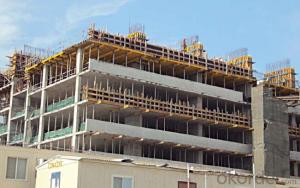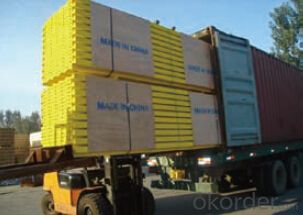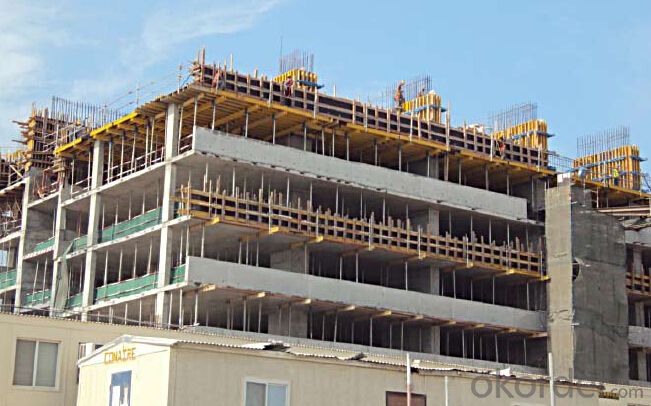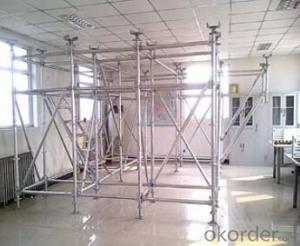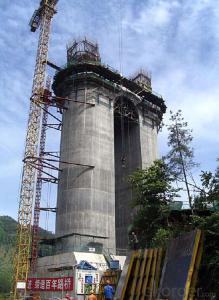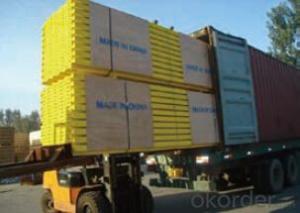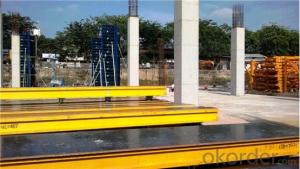Timber Beam Formwork H20 for formwork and scaffolding systems
- Loading Port:
- Tianjin
- Payment Terms:
- TT OR LC
- Min Order Qty:
- 50 m²
- Supply Capability:
- 1000 m²/month
OKorder Service Pledge
OKorder Financial Service
You Might Also Like
Characteristics:
◆ Standardized production lines.
Supply capability: 3000m/day, Lmax = 6600mm.
◆ Finger jointing of the flange and web, the strength of timber beam is highly improved.
Max. shearing force failure load:40KN
◆ Well treated to prevent from water penetration or erosion, so the service life maximally
extended.
Normally, CNBM timber beam H20 can be used for 4 to 5 years, the exact using time would
depend on maintenance & storage.
◆ Robust caps at the end of the girders protect against damages.
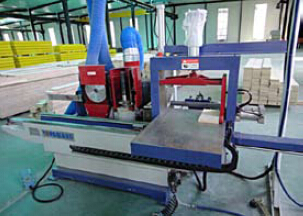
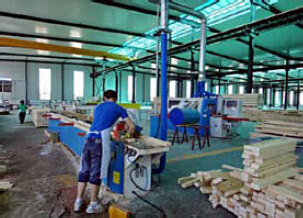
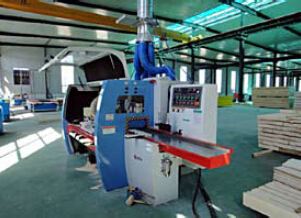
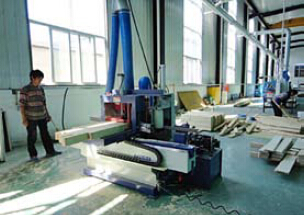
- Q: Can steel formwork be used for both thin and thick concrete elements?
- Indeed, both thin and thick concrete elements can be constructed using steel formwork. The versatility of steel formwork allows for easy adjustments and modifications to accommodate varying concrete thicknesses. This attribute contributes to its suitability for a wide range of construction projects, including walls, columns, beams, slabs, and intricate architectural structures. Furthermore, steel formwork ensures a seamless and accurate finish to the concrete, guaranteeing exceptional quality outcomes. Moreover, the durability of steel formwork permits its repeated use, rendering it a cost-effective option for both thin and thick concrete elements.
- Q: How is steel formwork installed?
- Accurate and sturdy construction is ensured through the systematic and efficient installation of steel formwork. The typical process involves the following steps: 1. Careful planning and preparation are essential before steel formwork installation. This includes determining the desired shape and dimensions of the concrete structure, calculating the required amount of steel formwork panels and accessories, and ensuring the availability of all necessary tools and equipment. 2. Adequate site preparation is necessary. This involves clearing the construction site of debris and obstacles, leveling the ground, and establishing a solid foundation. 3. The positioning and alignment of steel formwork panels are carried out according to the planned structure. Various methods, such as clamps, nuts, bolts, or pins, are used to connect and secure the panels. Proper alignment and tightness are crucial to prevent concrete leakage or seepage. 4. If necessary, steel reinforcement bars are installed within the formwork to provide additional strength and support to the concrete structure. These reinforcement bars are precisely placed and firmly secured to the formwork panels in accordance with the structural design. 5. Adequate bracing of the formwork is essential to ensure stability and prevent deformation during concrete pouring and curing. Horizontal and vertical bracing systems are utilized to provide the necessary support and rigidity, evenly distributing the load and maintaining the desired shape of the structure. 6. Concrete is poured into the securely placed and braced steel formwork. Vibrators or other suitable equipment are used to compact the concrete, eliminating air bubbles and promoting proper adhesion and density. 7. After pouring and compacting the concrete, it must be cured to achieve maximum strength and durability. Curing can be done using various methods, such as covering the structure with plastic sheets or water spraying. Once the concrete has sufficiently cured, the steel formwork can be carefully removed, starting from the top and gradually moving downwards. It is important to note that the installation process may vary depending on project requirements, the complexity of the structure, and the type of steel formwork used. Therefore, it is advisable to consult experienced professionals or engineers to ensure proper installation and adherence to safety standards.
- Q: Can steel formwork be used for concrete structures in corrosive environments?
- In corrosive environments, like those with high moisture levels or exposure to chemicals, steel formwork may be utilized for concrete structures. However, it is essential to take special precautions to guarantee its durability and longevity. Over time, steel can corrode and deteriorate due to these corrosive elements. To minimize this risk, proper coating of the steel formwork with corrosion-resistant materials, such as epoxy or galvanized coatings, is necessary to create a protective barrier. Furthermore, regular maintenance and inspections must be conducted to identify and address any signs of corrosion or damage. In extremely corrosive environments, alternative formwork materials like plastic or fiber-reinforced polymers may be more appropriate as they offer superior resistance to corrosion. Ultimately, the decision to use steel formwork in a corrosive environment should be based on a thorough evaluation of the specific conditions and the implementation of appropriate preventive measures to ensure the long-term durability of the concrete structure.
- Q: Can steel formwork be used for high-rise buildings?
- Yes, steel formwork can be used for high-rise buildings. Steel formwork is known for its durability, strength, and ability to withstand high concrete pressures. These characteristics make it suitable for constructing tall structures such as high-rise buildings. Steel formwork systems are designed to provide stability and support during the construction process, ensuring that the concrete is properly shaped and cured. Additionally, steel formwork can be easily assembled and disassembled, allowing for efficient construction and adaptability to different project requirements. Overall, steel formwork is a reliable and commonly used solution for high-rise building construction.
- Q: How is steel formwork different from other types of formwork?
- Steel formwork differs from other types of formwork primarily because it is constructed from steel, which provides several distinct advantages. Firstly, steel formwork exhibits exceptional durability and can endure heavy loads and repeated use without warping or damage. This makes it well-suited for utilization in extensive construction ventures where formwork must be employed multiple times. Furthermore, steel formwork is renowned for its remarkable strength and stability. It can support concrete walls and slabs without necessitating supplementary support structures, reducing construction time and expenses. Its inflexibility also guarantees that the formwork retains its shape and prevents concrete from leaking or shifting during pouring and curing. Another notable benefit of steel formwork is its adaptability and versatility. It can be easily tailored to meet diverse project requirements, enabling the construction of intricate shapes and designs. This flexibility renders steel formwork suitable for a wide array of applications, including tall buildings, bridges, tunnels, and even curved structures. Moreover, steel formwork provides excellent surface finish quality. Its smooth and uniform surface diminishes the need for additional finishing work, conserving time and resources. It also imparts a uniform appearance to the completed concrete structure. In terms of cost-effectiveness, steel formwork may entail a higher initial investment compared to other formwork types, such as wood or aluminum. However, its durability and reusability compensate for the higher upfront expenses in the long run. Additionally, the efficiency and rapidity of construction achieved with steel formwork can result in substantial time and labor savings, making it a cost-effective choice for large-scale projects. Overall, steel formwork distinguishes itself through its durability, strength, adaptability, surface finish quality, and cost-effectiveness. These characteristics render it a popular selection in the construction industry for projects that require a sturdy and dependable formwork system.
- Q: Can steel formwork be used for projects with aggressive concrete mixes?
- Yes, steel formwork can be used for projects with aggressive concrete mixes. Steel formwork is known for its strength, durability, and resistance to various environmental factors. Aggressive concrete mixes typically contain higher amounts of chemicals such as chlorides, sulfates, or alkalis, which can be corrosive to some materials. However, steel formwork is usually resistant to these aggressive chemical attacks and can withstand the harsh conditions associated with aggressive concrete mixes. It is important to ensure that the steel formwork used is properly coated or treated to enhance its resistance to corrosion and chemical attacks. Regular maintenance and inspection of the formwork are also necessary to identify and address any signs of deterioration or damage. Overall, steel formwork can be a suitable choice for projects with aggressive concrete mixes due to its strength and resistance to chemical attacks.
- Q: What are the considerations when designing steel formwork for architectural canopies?
- When designing steel formwork for architectural canopies, several important considerations need to be taken into account. These include: 1. Structural Integrity: The formwork must be designed to withstand the loads imposed by the canopy, including dead loads (self-weight), live loads (such as wind and snow), and any other potential loads such as hanging fixtures. The steel formwork should be structurally robust to ensure the stability and safety of the canopy. 2. Aesthetic Appeal: Architectural canopies are often designed to enhance the overall visual appeal of a building. Therefore, the steel formwork should be designed in a way that complements the desired aesthetics of the canopy. This could involve incorporating decorative elements, such as patterns or textures, into the formwork design. 3. Ease of Installation: The formwork should be designed for easy and efficient installation. This could involve using modular components that can be assembled quickly and easily on-site. It is also important to consider the weight and size of the formwork elements to ensure they can be handled and installed safely. 4. Durability and Maintenance: Steel formwork should be designed to withstand the environmental conditions to which it will be exposed. This may include protection against corrosion, UV radiation, and other potential causes of deterioration. Additionally, the formwork should be designed for easy maintenance and repair, if necessary. 5. Functionality: The formwork must be designed to accommodate any specific functional requirements of the canopy. This could include providing space for utility connections, such as lighting or drainage systems, or incorporating features such as rainwater collection systems. 6. Cost-effectiveness: The design of the steel formwork should consider the overall cost of the canopy project. This includes not only the initial cost of the formwork itself but also factors such as ease of transportation and installation, as well as long-term maintenance costs. Overall, the design of steel formwork for architectural canopies requires a careful balance between structural integrity, aesthetics, functionality, and cost-effectiveness. By considering these considerations, architects and engineers can ensure the successful implementation of canopies that are both visually appealing and structurally sound.
- Q: Can steel formwork be used for curved or irregular-shaped structures?
- Indeed, curved or irregular-shaped structures can be constructed using steel formwork. Unlike conventional timber formwork, steel formwork boasts enhanced flexibility and strength, rendering it ideal for intricate shapes and designs. With steel formwork, it is effortless to bend or fabricate it into any desired shape, facilitating the construction of curved walls, columns, and slabs. Furthermore, steel formwork delivers exceptional support and stability, guaranteeing the precision and accuracy of the eventual structure. Its durability and reusability further contribute to its cost-effectiveness in projects involving curved or irregular-shaped structures.
- Q: What are the different components of steel formwork?
- The different components of steel formwork include panels, stiffeners, walers, soldiers, ties, and connectors.
- Q: Can steel formwork be used in architectural concrete projects?
- Architectural concrete projects can indeed utilize steel formwork. Due to its durability, strength, and versatility, steel formwork is frequently chosen for various construction endeavors, including architectural concrete. By providing exceptional support and stability to the concrete structure, steel formwork ensures that the desired shape and form are maintained throughout the pouring and curing process. Additionally, steel formwork's resistance to warping or bending under the weight and pressure of the concrete is essential for achieving accurate and precise architectural designs. Moreover, steel formwork facilitates easy assembly and dismantling, making it a cost-effective option for architectural concrete projects. Overall, architects and builders seeking to create intricate and aesthetically pleasing concrete structures can rely on the reliability and efficiency of steel formwork.
Send your message to us
Timber Beam Formwork H20 for formwork and scaffolding systems
- Loading Port:
- Tianjin
- Payment Terms:
- TT OR LC
- Min Order Qty:
- 50 m²
- Supply Capability:
- 1000 m²/month
OKorder Service Pledge
OKorder Financial Service
Similar products
Hot products
Hot Searches
Related keywords

